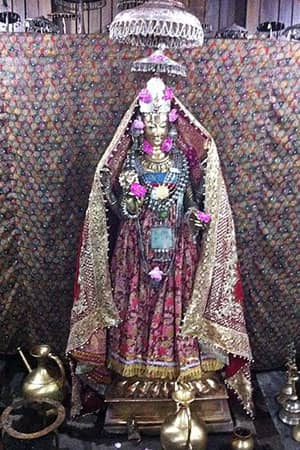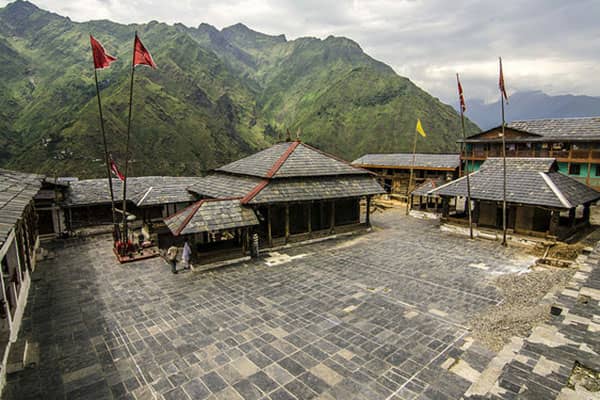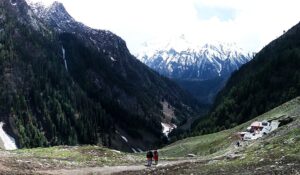Shivshakti Devi temple is located at village Chhatrari, 33 km from Bharmour. King Meru Verman fulfilled his vow by constructing Shivshakti Devi Temple at a height of 6,000 feet or  1,800 m. Shivshakti Devi temple was built in 650AD at the same period when Lakshana Devi temple of Bharmour was constructed.
1,800 m. Shivshakti Devi temple was built in 650AD at the same period when Lakshana Devi temple of Bharmour was constructed.
It is famous for its remarkable hill-style temple with wooden carvings and an attractive metallic idol of Devi, constructed by an artist by the name of Gugga. The construction of the temple is simple. It consists of a small Cell or sanctuary in which one of the rare brasses by the master craftsman Gugga is enshrined. The walls of the temple are built of rubble masonry alternating with beams of wood. The structure is surmounted by a sloping roof of slate. The roof is supported by richly carved wooden posts which form a VARANDAH or circumambulatory path round the sanctum.
The Shivshakti Devi temple is of interest owning to the elaborate decoration of its facade, ceiling and pillar. The sanctum, its architecture and sculpture betray a conscious effort on part of its builder to introduce a highly refined post Gupta art in this remote part of Chamba.
The main idol in the temple is of Shivshakti Devi. This fine brass statue, 4 feet 6 inches tall shows Shakti holding in her hands a lance (Power, energy) and a lotus (life), a bell (aether, space) and a snake (death and time). Besides this main idol there are almost thirty other small figurines of tutelary deities like Annapurna. Some of these are believed to have been brought from far South or the State of Orrisa.

According to the inscription at Chhatrari the temple was built by Raja Meru Varman, by whose order the inscription was engraved along with the names of his father, grandfather and great grandfather as well as that of the sculptor. This epigraph commemorates Meru Varman’s victory over his rivals with the help of the Devi. The outer walls of the sanctum are covered with frescoes which are of recent origin and represent scenes from PURANAS.
Near the Shivshakti Devi Temple, there is temple of Gauri Shankra. The stone image of Gauri Shankra is of later origin. The work can be attributed to the 10th century AD which indicates a long period of sculptural activity in the region. A few minutes’ walk up the mountain slopes from the main village is the Charauta temple which houses a stone image of BHATOD NAG who gives water to the people in return for one black and four white goats every three years.
There are two interesting legends connected with the village. Villagers had to fetch water from a nearby village call Makain. Once, a Chela of a siddha while carrying water became prey to bears. The Siddha invoked the deity to solve the water problem. Inspired by the Devi he made 36 marks with his trident at different places in the village and water gushed out from the points where the marks had been made. There are 36 water sources in the village around which beautiful PANIHARS (Fountain slabs) can be seen.
In the month of September a fair is held on the third day after Manimahesh Yatra when holy water from Manimahesh Lake is brought to the temple. This is also called Chhatrari fair or Chhatrari mela. Idol of Shivshakti Devi is bathed with the holy water from Manimahesh Lake.
Masked dance performed in the fair of Chattrari Fair. Chhatrari Fair is also called Shivshakti Devi Fair. On this day a number of sheep are slain to appease the goddess and to invoke her blessings. After the prayer the Gaddies in their traditional costumes dance to the tune of local music.


